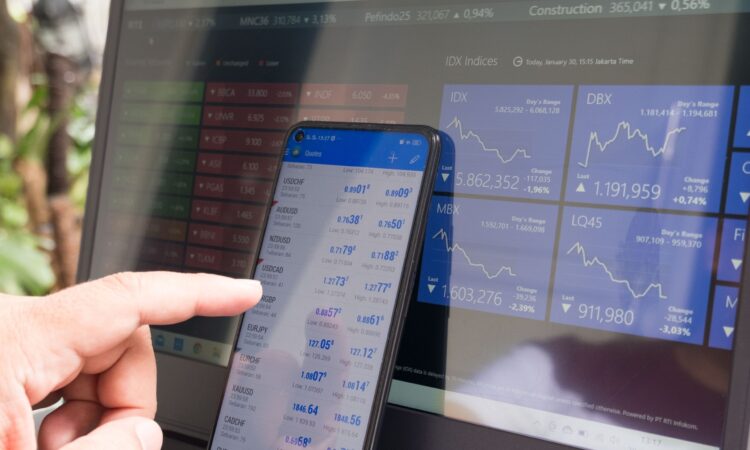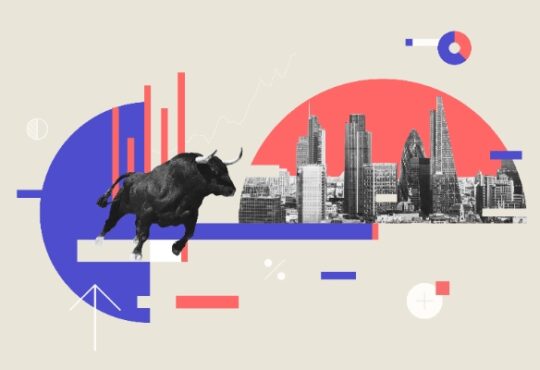
In the eyes of some – the Financial Conduct Authority (FCA) included – Contracts For Difference, or CFDs, are the equivalent of Phil Mitchell in Eastenders: mad, bad, and dangerous to know.
In December 2022, the FCA described CFDs as “highly leveraged derivatives”, before warning that “adverse price movements in relevant markets can lead to substantial losses for consumers”.
The FCA added that around 80% of customers lose money when investing in CFDs.
But even Phil Mitchell has his fans. For experienced, frequent traders familiar with financial markets, CFD trading has become a popular alternative to spread betting, providing investors with potential money-making opportunities across an array of asset classes including shares, foreign exchange and commodities.
Here’s a closer look at CFD trading and what it involves.
Trading CFDs is riskier than conventional share trading, not suitable for the majority of investors, and includes the potential for partial or total loss of capital. Investing is speculative, and your capital is at risk.
What is a Contract For Difference?
A CFD is a contract traded on a market that’s based on the value of an asset – for example the price of an individual share, commodity (such as gold), or currency (the UK pound, US dollar, etc).
The contract in question is created between a trader and, usually, either a spread betting firm or an investment bank, often for a matter of days or weeks. This contrasts with the longer-term buy-and-hold approach associated with conventional share investment.
Even normal stocks and shares investing is not for everyone because it carries the risk of loss of capital. CFD trading is a more extreme means of potentially making (and losing) money – arguably more akin to gambling than investing.
CFDs are especially popular with forex and commodities traders. As CFDs are a ‘derivative’, CFD traders do not own the underlying asset they are looking to bet on, such as a stock or a commodity. Rather, they are exposed to the price movements associated with that asset.
At the end of the contract, parties exchange the difference between the opening and closing prices of the financial instrument concerned.
What’s the appeal of CFDs?
CFDs allow traders to speculate about whether an asset’s price is going to rise or fall. The accuracy of that prediction determines whether a trader makes a profit or a loss.
A CFD investor who thinks an asset’s price is going to rise will buy a CFD, or ‘go long’. One who thinks the price will fall will look to sell a contract, known as ‘going short’.
Depending on price movements, it’s possible to make gains or losses from either tactic.
Going long versus going short
Unlike traditional share dealing, where buying a stock – or going long – is the only option, CFD trading also allows investors to sell assets they believe will fall in value.
Going short with CFDs works in the same way as going long. But instead of buying contracts to open a position, the investor sells them instead.
In doing so, an investor will open a trade that earns a profit if the underlying market falls in price but incurs a loss should the market go up.
In every CFD market there are two prices listed: the buy (or ask) price and the sell (or bid) price. To open a long position, investors trade at the buy price. To go short, they trade at the sell price.
To close the contract, investors do the opposite to what they did when they opened it.
How does CFD trading work?
CFD trading allows investors to buy or sell a number of units in a financial instrument that is linked to an underlying asset, rather than the asset itself. CFD providers such as spread betting companies typically offer exposure to a range of global markets including currency pairs, stock indices, commodities and shares.
Instead of choosing how much of a particular asset he or she would like to buy – such as 100 AstraZeneca shares – a CFD trader selects how many contracts they want to buy or sell.
If the market moves in favour of a trader, his or her position will earn a profit. Should it move against, the trader will incur a loss. Profits or losses are realised when a position is closed and the contracts that had been bought at the outset of the bet are sold.
As with conventional share dealing, the return from a trade is determined by the size of the investor’s position and the number of points the market in question has moved.
For example, say an investor buys 100 Shell share CFDs at 500p and then sells them at 550p. In this instance the gain would be £50. If the CFDs were sold at 450p the loss would be £50.
Because CFD trading concerns price movements rather than ownership of an underlying asset, investors are exempt from UK stamp duty on any profits. As a form of gambling, spread betting is also exempt from capital gains tax.
What’s the risk with CFD trading?
CFDs are a ‘leveraged’ product, which means traders only need to deposit a small percentage of the full value of a trade to open a position. This is referred to as ‘trading on margin’ or ‘margin requirement’ (see below).
This means a would-be trader can put up a small amount of money to account for a much larger investment. Doing this can magnify any potential return on investment. But, crucially, the process works the other way as well, meaning that losses incurred would be similarly enlarged.
The upshot of this is that, rather than just the cost of an initial bet, a trader who calls a market incorrectly could, potentially, lose all the money they deposited in an account with the CFD provider.
For example, a £100 bet that the oil price will rise could lead to a loss of more than £100 if the oil price were to fall. The further the oil price fell, the more money the trade would go on to lose.
If a trader went on to lose £500 on such a bet and had at least £500 deposited with the CFD provider, he or she would lose all £500, not just the £100 stake.
More on margins
The capital required by a trader in his or her account and to open and maintain a leveraged position is referred to as ‘margin’. Margin is typically presented as a percentage of the total trade size and the amount required varies from market to market.
To open a forex position, a CFD trader might be required to have 5% of the total value in his or her account. Opening a share position might need a larger amount – between 25% and 30% of the trade size.
As an example, buying five oil CFDs at £5,325 would work out to a total position size of (5x 5,325) £26,625. If oil required a 10% margin, then the trader would require 10% of £26,625, or £2,662.50 in his or her account to open the trade.
What determines returns?
Instead of choosing how much of a particular asset he or she would like to buy – such as 100 AstraZeneca shares – a CFD trader selects how many contracts they want to buy or sell.
If the market moves in favour of a trader, his or her position will earn a profit. Should it move against, the trader will incur a loss. Profits or losses are realised when a position is closed and the contracts that had been bought at the outset of the bet are sold.
As with conventional share dealing, the return from a trade is determined by the size of the investor’s position and the number of points the market in question has moved.
For example, say an investor buys 100 Shell share CFDs at 500p and then sells them at 550p. In this instance the gain would be £50. If the CFDs were sold at 450p the loss would be £50.
Because CFD trading concerns price movements rather than ownership of an underlying asset, investors are exempt from UK stamp duty on any profits. As a form of gambling, spread betting is also exempt from capital gains tax.
Going long versus going short
Unlike traditional share dealing, where buying a stock – or going long – is the only option, CFD trading also allows investors to sell assets they believe will fall in value.
Going short with CFDs works in the same way as going long. But instead of buying contracts to open a position, the investor sells them instead.
In doing so, an investor will open a trade that earns a profit if the underlying market falls in price but incurs a loss should the market go up.
In every CFD market there are two prices listed: the buy (or ask) price and the sell (or bid) price. To open a long position, investors trade at the buy price. To go short, they trade at the sell price.
To close the contract, investors do the opposite to what they did when they opened it.
What are CFDs used for?
As CFDs allow investors to short sell, they are often used as insurance to offset or ‘hedge’ losses made in physical share portfolios.
For example, if an investor held £5,000 of BT shares and was concerned that they were due for an imminent sell-off, one option would be to short sell £5,000 of BT CFDs to help protect a portfolio.
Should BT’s share price fall by 5% in the underlying market, the loss in the share portfolio would be offset by a gain in the short trade. In this way, an investor could protect his or her share exposure without going through the expense and inconvenience of liquidating existing shareholdings.
What are the costs of CFD trading?
There are three basic ways that CFD traders are charged.
First is the spread, which is the difference between the ‘bid’ and ‘ask’ prices. The presence of a spread means that a trade must move a certain amount in a positive direction before a trader can sell it back for what he or she paid for it. Spreads are not large but are worth comparing from broker to broker.
Some trading platforms will say that their trading is commission-free. But, to make up for this, they may impose wider spreads making it all the more important to consider the overall fee package before choosing a provider.
A commission charge is also quite common, usually a fraction of a percent of the value of the underlying security when a position is being traded out. Separate commission may not be charged where indices, rather than individual securities, are being traded.
In addition, CFDs usually levy a daily interest charge whenever a position is held overnight, and this is usually applied at a previously agreed rate. CFD traders who take short positions instead of long ones may receive interest on the value of a trade.
The interest rate that’s paid for going long or short will be set out in an account’s opening letter.
CFDs and dividends
Dividends are payouts made by companies to their shareholders usually paid out from annual profits.
In the case of stock-related CFDs (but not contracts based around indices), traders will receive a dividend providing they own a contract prior to the ex-dividend date. This is the day where potential buyers of a company’s shares stop being eligible for an upcoming dividend payment.
While a contract position remains open, accounts are debited or credited to reflect interest and dividend adjustments. The direction of interest and dividend adjustments depends on whether a CFD is being used to create a long or short position.
In the case of a long position, an account will be debited to reflect interest adjustments and credited to take account of dividend payments. In the case of a short position, accounts are credited with interest adjustments and debited to reflect dividend payments.
CFDs and the UK regulator
CFD trading is legal in the UK but, as we saw above, the financial regulator has been vocal about the large number of consumers who lose money when participating in this activity.
The FCA says that, where CFDs and CFD-like options are sold to retail clients, providers must:
- limit leverage to between 30:1 to 2:1
- close out a customer’s position when their funds fall to 50% of the margin needed to maintain their open positions on their CFD account
- provide protections that guarantee a client cannot lose more than the total funds in their CFD account
- stop offering monetary and non-monetary inducements to encourage trading
- provide a standardised risk warning, which requires firms to tell potential customers the percentage of their retail client accounts that make losses.
The Securities and Exchange Commission, the US equivalent of the FCA, has banned CFD trading entirely. Other countries such as France, Germany and South Africa permit the trading of CFDs, but in some jurisdictions the guidelines are even harsher than for the UK.
How to find a CFD provider
To trade CFDs it’s necessary to open an account with a provider that facilitates them. Note that not all traditional online stockbrokers or trading platforms offer CFDs, although there is plenty of competition in the UK.
This has resulted in favourable terms for would-be traders with better pricing structures and enhanced features. Investors should always look for providers that are FCA-authorised or equivalent. Tight regulation provides extra financial protection for consumers and their cash.
Unfortunately, the FCA says the sector has attracted a number of firms, often accessing the UK from overseas, that “do not deliver good customer outcomes”. In some of the worst firms, the FCA refers to fake celebrity endorsements, the use of pressure-sales tactics to persuade clients to invest increasing amounts of money and customer inducements.
These should be avoided at all costs and should firms looking to provide investment advice without the due authorisation.
On a more positive note, some providers offer a demonstration account allowing would-be traders to play the markets with virtual money. This is a useful way to learn how CFDs work without risking real money.
Trading platforms should be easy to use and be able to execute trades quickly and efficiently. Before signing up, depending on personal preferences, investors should check whether a platform is supported via both desktop and mobile, provides access to educational material and research tools, is easy to navigate and offers 24/7 customer support.
UK CFD brokers may differ in their terms for depositing and withdrawing cash, so investors should check beforehand to find the best fit.






